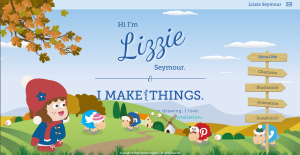Creating Your Brand Personality
When creating your brand personality there are a couple of things to keep in mind. First is to decide what part of your personality you want to show in your brand. Infuse an interest you have or part of your personality with your brand. You also want to make your brand memorable; come up with something that will make you stick out. Another thing to consider when branding yourself is if you create this character for yourself, do you want to be “in character” all the time? And if you are going to be in character what props are you going to use to deliver your message?
Lizzie Seymour is a good example of a designer who has created a strong digital identity for herself. She has created a character called Little Lizzie to represent herself and uses it on her social media. By using this characterization of herself across different platforms she has made her brand memorable.
Robby Leonardi is also an example of a designer that has created a strong digital identity. He does animation work and for both his portfolio and resume he has created interactive sites. With his resume the character moves along as you scroll and it is kind of like a video game. With his portfolio projects move onto the screen or are revealed from behind doors as you scroll. By creating these interactive sites he has created something memorable.
Tips for Designing a Portfolio Site
There are some tips you should keep in mind when designing your portfolio. One of them is that you should include a tagline that is short and to the point. It should summarize what you do. You also want to include what services you provide; expand on what your tagline is. Another tip is that when writing your about me section you want to give as much detail as possible because the more information you give the more the user is likely to build a bond. You also want to make your contact info as visible as possible; you can even use a form to allow users to contact you easier.
Here are some examples of well designed portfolio sites:
Charlotte Tang and Adhemas Batista are two good examples of portfolio sections of their site. Tang’s site has rollover images that when rolled over provide a little bit of information about the project, but when clicked on you are taken to a page dedicated to that project. This page provides a more in-depth look at the project and what she did.
Batista’s website has large images of his projects displayed and when an image is clicked the user is taken to another page that gives a brief description of the work. With his website the work itself is more of the focal point.
Paul Currah and Jeremy Sallee are two designers that have good about me sections on their portfolio site. Currah provides a lot of information about his background, experience, and how he approaches a project all in a professional manner. Sallee on the other hand provides similar information but with hints of humor here and there.
Steven Bonner and Olly Gibbs‘ portfolio sites are examples of two different ways to include contact information. Bonner’s contact information is always visible on his site no matter what page you are on. Gibbs on the other hand created a separate contact page where he included a form so users can easily contact him directly from his site.
Robby Leonardi and Jesse Willmon have sites that showcase different styles for resumes. Leonardi created an interactive site for his portfolio that engages the user instead of just having them read type on a page. The site also has a contact section at the end as well as a PDF download of his resume. Willmon’s resume is just another page in the portfolio site that contains the resume as well as a PDF download of the information.

